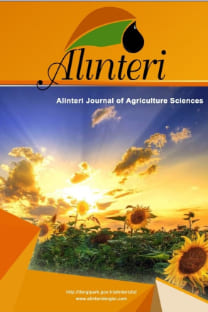Feeding Preferences of the Rearing of Thanasimus formicarius (L.) (Coleoptera, Cleridae)
Thanasimus formicarius (L.) (Coleoptera, Cleridae)’un Üretilmesinde (Rearing) Beslenme Tercihi
___
Alston, D. G., 2011. General concepts of biological Control. UTAH pests fact sheet. IPM-015-11. Published by Utah State University Extension and Utah Plant Pest Diagnostic Laboratory.Anderegg, W. R. L., Hicke, J. A., Fisher, R. A., Allen, C. D., Aukema, J., Bentz, B., Hood, S., Lichstein, J. W., Macalady, A. K., McDowell, N., Pan, Y. Raffa, K., Sala, A., Shaw, J. D., Nathan, L., Stephenson, N.L., Tague, C., and Zeppel, M., 2015.Tree mortality from drought, insects, and their interactions in a changing climate. New Phytol. 208: 674 – 683.
Black S. H., Kulakowski D., Noon, B. R., and DellaSala D., 2010. Insects and roadless forests: a scientific review of causes. Consequences and Management Alternatives. National Center for Conservation Science 33pp.
Costello, S. 2003. Clerid beetles- voracious predators" PDF. Colorado State University Department of Entomology. 1–15.
Fettig, C. J., Klepzig, K. D., Billings, R. F., Munson, A. S., Nebeker, T. E., Negrón, J. F., and Nowak, J. T., 2007. The effectiveness of vegetation management practices for prevention and control of bark beetle infestations in coniferous forests of the western and southern United States. Forest Ecology and Management 238, 24-53.
Fettig, C. J and Hilszczannski J., 2015. Management strategies for bark beetles in conifer Forests. In: Vega FE, Hofstetter RW (eds.). Bark Beetles. Biology and Ecology of Native and Invasive Species. Elsevier, Amsterdam. 555–584.
Gullan, P. J., and Cranston P. S., 2012. Böcekler: entomolojinin ana hatları. Bölüm 16. The insect an outline of entomology. Fourth Edition. Wiley-Blackwell. Çeviri Editörü: Ali Gök. XVI+564
Lingren, B. S., and Raffa, K. F., 2013. .Evolution of tree killing in bark beetles (Coleoptera: Curculionidae): trade-offs between the maddening crowds and a sticky situation. 145, 5, 471-495. https://doi.org/10.4039/tce.2013.27
Mack, R. N., Simberloff, D., Lonsdale, E. M., Evans, H., Clout, M., and Bazzaz, F. A., 2000. Biotic invasions: causes, epidemiology, global consequences and control. Ecol. Appl. 10, 3, 689–710
Marini, L., Økland, B., Jönsson, A. M., Bentz, B., Carroll, A., Forster, B., Grégoire, J. C., Hurling, R., Nageleisen, L. M., Netherer, S., Ravn, H.P., Weed, A., and Schroeder, M., 2017. Climate drivers of bark beetle outbreak dynamics in Norway spruce forests. Ecography 40: 001– 010, doi: 10.1111/ecog.02769
Moeck, H. A, and Safranyik, L., 1984. Assessment of predator and parasitoid control of bark beetles. Can For Serv Inf Rep BC-X-248
Morris, J. L; Cottrell, S., Fettig, C. J., DeRose, R. J., Mattor, K. M., Carter, V. A., Clear, J., Clement, J., Hansen, W. D., Hicke, J. A., Higuera, P. E., Seddon, A. W. R., Seppä, H., Sherriff, R. L; Stednick, J. D., and Seybold, S. J., 2018. Bark beetles as agents of change in socialecological systems. Frontiers in Ecology and the Environment. 16(S1): S34-S43. https://doi.org/10.1002/fee.1754.
Özcan, G. E., 2017a. The effect of the moisture content of scotch pines by bark beetle attacks. IV. IMCOFE / ROME, Abstract Book, 230 p.
Özcan, G. E., 2017b. Assessment of Ips sexdentatus population considering the capture in pheromone traps and their damages under non-epidemıc conditions. Journal of the Forestry Society of Croatia. Šumarski List. 1-2, 47-56.
Pearson, D. E., and Callaway, R.M., 2003. Indirect effects of host-specific biological control agents. TRENDS in Ecology and Evolution, 18 , 9, 456-461.
Powers, J. S., Sollins, P., Harmon, M.E., Julia A., and Jones, J.A., 1999. Plant-pest interactions in time and space: A Douglas-fir bark beetle outbreak as a case study. Landscape Ecology 14: 105–120.
Raffa, K. E, Grégoire, J. C, and Lindgren, B. S., 2015. Natural history and ecology of bark beetles. Bark Beetles Biology and Ecology of Native and Invasive Species. Elsevier. Chapter 1, 1-28pp.
Reeve, J. D., 1997. Predation and bark beetle dynamics. Oecologia, 112, 48-54
Uygun, N., Ulusoy, M. R., and Satar, S., 2010. Biological control. Türk. biyo. müc. derg.,, 1 (1): 1-14.
Warzee, N., and Grégoire, J. C., 2003. Thanasimus formicarius (Coleoptera, Cleridae) Why a Large Range of Prey for a Specialized Predator? Proccedings. IUFRO Kanazawa, Forest Insect Population Dynamics and Host Influences, 16–18.
Turchin, P., Taylor, A. D., and Reeve, J. D., 1999. Dynamical role of predators in population cycles of a forest insect: an experimental test. Science 285, 1068–1071.
- ISSN: 2564-7814
- Yayın Aralığı: 2
- Başlangıç: 2007
- Yayıncı: Adem Yavuz SÖNMEZ
Iman Daw AMHAMED, Gamaia Ali MOHAMED, Ahmed Alhadi ALMABROK, Tarek Abdalsalam Salem ALTIEF, SONER BİLEN
Berrin OKUYUCU, MEHMET LEVENT ÖZDÜVEN, FİSUN KOÇ
Mete YANAR, Olcay GÜLER, Abdulkerim DİLER, Recep AYDIN, Rıdvan KOÇYİĞİT
Berna DOĞRU ÇOKRAN, Mücahit PEHLUVAN, M. Ramazan BOZHÜYÜK
Thanasimus formicarius (L.) (Coleoptera, Cleridae)’un Üretilmesinde (Rearing) Beslenme Tercihi
Gonca Ece ÖZCAN, Nazlı KOÇOĞLU
Investigation of Pathological Lesions and Fetal Losses in Slaughtered Cattle
SERDAR ALTUN, SELİM ÇOMAKLI, Kübra A. TERİM KAPAKIN, MEHMET CENGİZ
MÜCAHİT PEHLUVAN, BERNA DOĞRU ÇOKRAN, M. Ramazan BOZHÜYÜK
Mehmet CENGİZ, Serdar ALTUN, Selim ÇOMAKLI, Kübra A. TERİM KAPAKIN
Edible Film and Coating Applications in Fruits and Vegetables
